Aviary netting is a crucial tool for bird enthusiasts, aviary owners, and agricultural professionals. It serves a vital role in bird safety and containment.
But what exactly is aviary netting? It’s a type of barrier designed to keep birds within a designated area. It also prevents unwanted birds from entering certain spaces.
Choosing the right aviary netting can be a complex task. It involves understanding the needs of your birds and the specific requirements of your space.
This guide aims to simplify that process. We’ll delve into the various types of aviary netting, their uses, and how to select the right one for your needs.
Whether you’re a bird lover looking to create a safe space for your feathered friends, or a professional seeking effective bird control solutions, this guide is for you. Let’s explore the world of aviary netting together.
Understanding Aviary Netting
Aviary netting is more than just a physical barrier. It’s a protective measure designed to ensure the safety and well-being of birds.
It’s used in various settings, from private aviaries and zoos to agricultural areas. The netting serves to contain birds within a designated area, prevent unwanted birds from entering, and protect crops from bird damage.
What is Aviary Netting?
Aviary netting is a type of mesh or net used to enclose birds. It’s designed to be strong and durable, capable of withstanding the elements and the activities of the birds it contains.
The netting comes in various sizes and materials, each with its own set of advantages and disadvantages. The choice of netting depends on the type of birds, the purpose of the enclosure, and the specific requirements of the space.
The Importance of Protecting Your Birds
Birds, whether in a private aviary or a public zoo, need protection. Aviary netting provides this protection, keeping birds safe from predators and preventing them from escaping.
Moreover, the netting also protects birds from harmful elements in the environment. It can prevent the spread of diseases and keep birds safe from harmful substances.
Types of Aviary Netting Materials
Aviary netting is made from various materials. The most common ones are polyethylene, nylon, and stainless steel.
Polyethylene netting is lightweight and resistant to UV radiation. It’s also affordable, making it a popular choice for many bird owners.
Nylon netting, on the other hand, is known for its strength and durability. It’s often used in larger aviaries and zoos.
Stainless steel netting is the most durable of all. It’s resistant to corrosion and can withstand extreme weather conditions. However, it’s also the most expensive option.
Handwoven stainless steel netting is widely used for various bird netting, big birds cage, aviary mesh. Commonly used Bird park, , all kinds of type of bird netting, parrot cages, ostrich, flamingo cages fence.
Recommended aviary mesh & netting specifications
We accept customized rope diameter, material and mesh size. The wire rope is smooth, protecting the fur from being damaged.
We provide the regular specifications for your reference.
| Item ID | Mesh Details | Material |
|---|---|---|
| HM1220 | 3/4″ x 3/4″ x 3/64″ | SS304/316 |
| HM1225 | 1″ x 1″ x 3/64″ | SS304/316 |
| HM1238 | 1.5″ x 1.5″ x 3/64″ | SS304/316 |
| HM1250 | 2″ x 2″ x 3/64″ | SS304/316 |
| HM1625 | 1″ x 1″ x 1/16″ | SS304/316 |
| HM1638 | 1.5″ x 1.5″ x 1/16″ | SS304/316 |
| HM1650 | 2″ x 2″ x 1/16″ | SS304/316 |
| HM2038 | 1.5″ x 1.5″ x 5/64″ | SS304/316 |
| HM2050 | 2″ x 2″ x 5/64″ | SS304/316 |
| HM2438 | 1.5″ x 1.5″ x 3/32″ | SS304/316 |
| HM2450 | 2″ x 2″ x 3/32″ | SS304/316 |
| HM3250 | 2″ x 2″ x 1/8″ | SS304/316 |
| HM3276 | 3″ x 3″ x 1/8″ | SS304/316 |
Selecting the Right Netting for Your Aviary
Choosing the right aviary netting is crucial. It’s not just about picking the strongest or the most affordable option. It’s about finding the netting that best suits your birds’ needs and your specific circumstances.
Factors to consider include the type of birds you have, the size of the enclosure, and the environmental conditions. You also need to think about the purpose of the netting, whether it’s for containment, exclusion, or protection.
Mesh Size Matters
The size of the mesh in your aviary netting is important. It should be small enough to prevent your birds from escaping, but large enough to allow them to move freely and comfortably.
The mesh size also affects visibility. Smaller mesh sizes may obstruct the view, while larger ones offer better visibility. However, larger mesh sizes may also allow smaller birds or predators to pass through.
Material Pros and Cons
Each material used in aviary netting has its pros and cons. Polyethylene is affordable and lightweight, but it may not be as durable as other materials. Nylon is strong and durable, but it can be more expensive.
Stainless steel is the most durable and resistant to weather conditions, but it’s also the most expensive. It may also be heavier, which could be a factor if you’re installing the netting yourself.
UV Protection and Durability
UV protection is an important factor to consider when choosing aviary netting. Netting that is UV-stabilized will last longer and provide better protection for your birds.
Durability is also crucial. The netting should be able to withstand the activities of your birds and the environmental conditions in your area. It should also be resistant to corrosion, especially if you live in a coastal area.
Installation Tips for Aviary Netting
Installing aviary netting can be a DIY project if you’re handy. However, it’s important to do it right to ensure the safety of your birds and the longevity of the netting.
Before you start, gather all the necessary tools and materials. You’ll need the netting, a tape measure, scissors or a utility knife, and fasteners suitable for your enclosure’s structure.
Preparing for Installation
Start by measuring the area where you’ll install the netting. Be sure to account for all sides of the enclosure, including the top. It’s better to have a little extra netting than not enough.
Next, clean the area where you’ll attach the netting. Remove any debris or sharp objects that could damage the netting or hurt your birds.
Finally, lay out the netting and cut it to size. Be careful not to cut the mesh too small, as this could create gaps where birds could escape.
Step-by-Step Installation Guide
Now you’re ready to install the netting. Here’s a basic step-by-step guide:
- Start at one corner of the enclosure and secure the netting with a fastener.
- Stretch the netting across to the opposite corner, keeping it taut but not overly tight.
- Secure the netting at this corner, then continue to the next corner.
- Repeat this process until the netting is secured on all sides.
Remember, the goal is to create a secure, comfortable environment for your birds. Take your time and make sure the netting is installed properly.
Maintenance and Care for Longevity
Once your aviary netting is installed, it’s important to maintain it properly. This will ensure it lasts as long as possible and continues to provide a safe environment for your birds.
Regular inspections and cleaning are key parts of this maintenance. Let’s look at each of these in more detail.
Regular Inspections
Inspect your aviary netting regularly for any signs of damage. Look for holes, tears, or areas where the netting has become loose or saggy.
If you find any issues, repair or replace the damaged section immediately. This will prevent birds from escaping or predators from getting in.
Cleaning Your Aviary Netting
Cleaning your aviary netting is also important. Over time, bird droppings, feathers, and other debris can build up on the netting.
Use a soft brush and warm soapy water to gently clean the netting. Rinse thoroughly and let it dry completely before allowing your birds back into the enclosure.
Legal and Ethical Considerations
When installing aviary netting, it’s crucial to consider legal and ethical aspects. These considerations ensure the well-being of the birds and compliance with wildlife protection laws.
Compliance with Wildlife Laws
Different regions have specific laws regarding bird enclosures. Make sure to research and comply with these laws when installing your aviary netting.
Non-compliance can lead to penalties. It’s always better to be safe and ensure your aviary meets all legal requirements.
Ensuring Ethical Treatment of Birds
Beyond legalities, ethical treatment of birds is paramount. The netting should not harm the birds or restrict their natural behavior excessively.
Choose netting that allows for natural light and air flow. This contributes to the overall well-being of the birds in your care.
Aviary Netting in Different Environments
Aviary netting is versatile and can be used in various settings. Its application is not limited to aviaries alone. It can be used in zoos, farms, and even urban environments.
Private and Public Aviaries
In private and public aviaries, netting serves as a barrier. It keeps the birds in and potential threats out. It also allows for the creation of specialized habitats within the aviary.
Netting can be customized to fit various enclosure shapes and sizes. This makes it ideal for both small private aviaries and large public ones.
Agricultural and Conservation Uses
In agricultural settings, aviary netting is used for bird control. It prevents birds from damaging crops and spreading diseases.
Conservation efforts also utilize aviary netting. It helps protect endangered bird species and serves as a deterrent for predators.
Conclusion and Next Steps
Aviary netting is a crucial tool for bird protection and containment. It offers a versatile solution for various environments, from private aviaries to agricultural fields.
Choosing the right netting and installing it correctly can ensure the safety and well-being of your birds. Remember to consider the material, mesh size, and durability when selecting your aviary netting.
Aviary mesh & netting for birds
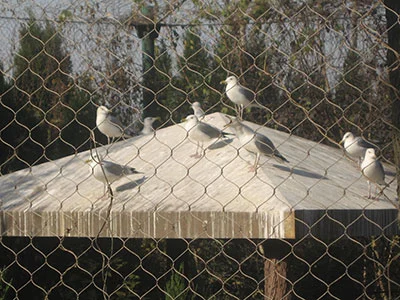
Recommended specifications :
Handwoven stainless steel netting HM1225;
Details:
Stainless steel wire rope: 3/64″ (1.2 mm);
Mesh opening size: 1″ x 1″ (25.4 mm x 25.4 mm);
Wire mesh for toucan exhibit
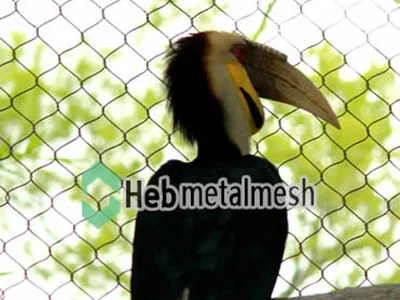
Recommended specifications :
Handwoven stainless steel netting HM1638;
Details:
Stainless steel wire rope: 1/16″ (1.6 mm);
Mesh opening size: 1.5″ x 1.5″ (38 mm x 38 mm);
Aviary mesh for white peafowl exhibit enclosure

Recommended specifications :
Handwoven stainless steel netting HM1638;
Details:
Stainless steel wire rope: 1/16″ (1.6 mm);
Mesh opening size: 1.5″ x 1.5″ (38 mm x 38 mm);
Aviary netting for Red-crowned crane enclosures
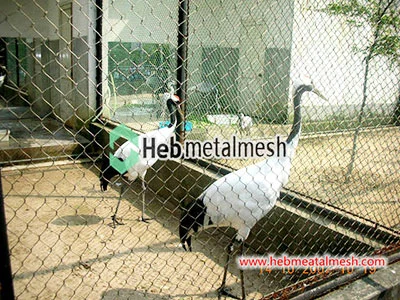
Recommended specifications :
Handwoven stainless steel netting HM1650;
Details:
Stainless steel wire rope: 1/16″ (1.6 mm);
Mesh opening size: 2″ x 2″ (51 mm x 51 mm);
Aviary Mesh & Netting for Ostrich Exhibit Mesh
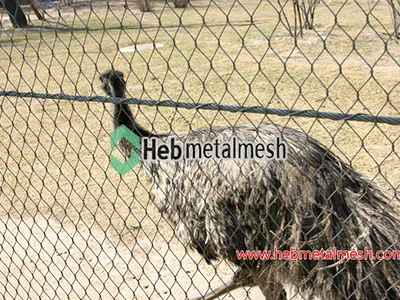
Recommended specifications :
Handwoven stainless steel netting HM2050;
Details:
Stainless steel wire rope: 5/64″ (2.0 mm);
Mesh opening size: 2″ x 2″ (51 mm x 51 mm);
Wire mesh for Pheasant exhibit, pheasant enclosure mesh
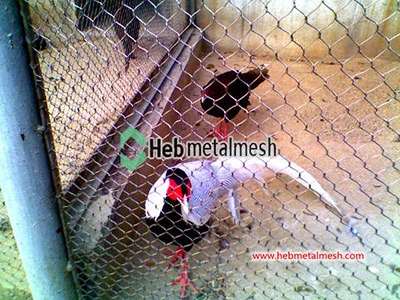
Recommended specifications :
Handwoven stainless steel netting HM1638;
Details:
Stainless steel wire rope: 1/16″ (1.6 mm);
Mesh opening size: 1.5″ x 1.5″ (38 mm x 38 mm);
aviary mesh & netting for flamingo, flamingo enclosure mesh
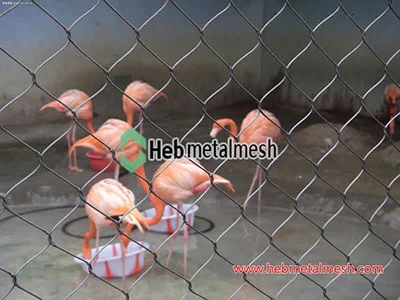
Recommended specifications :
Handwoven stainless steel netting HM1650;
Details:
Stainless steel wire rope: 1/16″ (1.6 mm);
Mesh opening size: 2″ x 2″ (51 mm x 51 mm);
Aviary mesh & netting for Macaw, macaw enclosure mesh

Recommended specifications :
Handwoven stainless steel netting HM2450;
Details:
Stainless steel wire rope: 3/32″ (2.4 mm);
Mesh opening size: 2″ x 2″ (51 mm x 51 mm);
In general, the size of the bird determines the mesh. The strength of the bird determines the diameter of the wire rope. Specific specifications need to be selected according to the actual birds. Choosing the right product specifications can effectively reduce project costs.
Zoo mesh with a gauge of 3/64″ or 1/16″ and a size of 3/4 inch or 1 inch is commonly used for outdoor aviaries. This provides good ventilation and protection from predators while still allowing birds to move around freely. It’s also important to ensure that the mesh is rust-resistant and coated with a non-toxic material to avoid harming the birds.
Handwoven stainless steel netting is safe for birds as it is durable, rust-resistant, and does not contain any harmful chemicals. It is also strong enough to prevent birds from escaping or predators from entering, while still allowing sunlight and fresh air to pass through. Additionally, the openings in the netting are small enough to prevent birds from becoming entangled.